#Suspicious Research Climate
Explore tagged Tumblr posts
Text
Chinese Scientists Are Leaving the United States! Here’s Why That Spells Bad News For Washington.
— By Christina Lu and Anusha Rathi | July 13, 2023 | Foreign Policy
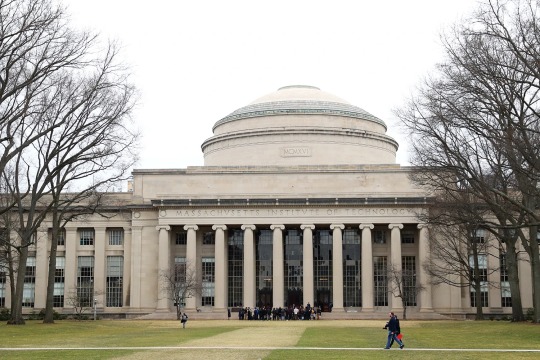
A view of Building 10 on the campus of Massachusetts Institute of Technology in Cambridge, Massachusetts, in the United States on March 12, 2020. Maddie Meyer/Getty Images
Facing an increasingly suspicious research climate, a growing number of Chinese scientists are leaving the United States for positions abroad, the latest indicator of how worsening U.S.-China relations are complicating academic collaboration and could hamstring Washington’s tech ambitions.
Chinese scientists living in the United States have for decades contributed to research efforts driving developments in advanced technology and science. But a growing number of them may now be looking elsewhere for work, as deteriorating geopolitical relations fuel extra scrutiny of Chinese researchers and Beijing ramps up efforts to recruit and retain talent. Between 2010 and 2021, the number of Chinese scientists leaving the United States has steadily increased, according to new research published last month. If the trend continues, experts warn that the brain drain could deal a major blow to U.S. research efforts in the long run.
“It’s absolutely devastating,” said David Bier, the associate director of immigration studies at the Cato Institute. “So many of the researchers that the United States depends on in [the] advanced technology field are from China, or are foreign students, and this phenomenon is certainly going to negatively impact U.S. firms and U.S. research going forward.”
From semiconductor chips to artificial intelligence, technology has been at the forefront of U.S.-China competition, with both Washington and Beijing maneuvering to strangle each other’s sectors. Cooperation, even in key sectors like combating climate change, has been rare.
From 2010 to 2021, the number of scientists of Chinese descent who left the United States for another country has surged from 900 to 2,621, with scientists leaving at an expedited rate between 2018 and 2021, according to research published in the Proceedings of the National Academy of Sciences (PNAS). Nearly half of this group moved to China and Hong Kong in 2010, the study said, and a growing percentage of Chinese scientists have relocated to China over the years.
While this number represents a small fraction of the Chinese scientists in the United States, the uptick reflects researchers’ growing concerns and broader apprehension amid a tense geopolitical climate. After surveying 1,304 Chinese American researchers, the report found that 89 percent of respondents wanted to contribute to U.S. science and technology leadership. Yet 72 percent also reported feeling unsafe as researchers in the United States, while 61 percent had previously considered seeking opportunities outside of the country.
“Scientists of Chinese descent in the United States now face higher incentives to leave the United States and lower incentives to apply for federal grants,” the report said. There are “general feelings of fear and anxiety that lead them to consider leaving the United States and/or stop applying for federal grants.”
The incentives to leave are twofold. Beijing has funneled resources into research and development programs and has long attempted to recruit scientists, even its own, from around the world. For one of its initiatives, the Thousand Talents Plan, Beijing harnessed at least 600 recruitment stations worldwide to acquire new talent. “China has been really trying to lure back scientists for a long time,” said Eric Fish, the author of China’s Millennials.
But this latest outflow of Chinese scientists accelerated in 2018, the same year that then-U.S. President Donald Trump unveiled the China Initiative, a controversial program that was aimed at countering IP theft—and cast a chill over researchers of Chinese descent and collaborations with Chinese institutions. In 2020, he also issued a proclamation denying visas for graduate students and researchers affiliated with Chinese universities associated with the military.
Although the Biden administration shut down the China Initiative, experts warn that its shadow still looms over Chinese scientists. More than one-third of respondents in the PNAS survey reported feeling unwelcome in the United States, while nearly two-thirds expressed concerns about research collaboration with China.
“There is this chilling effect that we’re still witnessing now, where there is a stigma attached to collaboration with China,” said Jenny Lee, a professor at the Center for the Study of Higher Education at the University of Arizona.
The challenges are emblematic of how the breakdown in U.S.-China relations has thrown universities into a geopolitical firestorm, particularly as some states’ lawmakers pressure them to sever ties with Chinese counterparts. On the U.S. side, interest in Mandarin language studies and study abroad has plummeted over the years, largely the result of worsening ties, Beijing’s growing repression, and the coronavirus pandemic. Today, while there are roughly 300,000 Chinese students in America, only 350 Americans studied in China in the most recent academic year. If interest continues to recede, experts warn of spillover effects that could hamper Washington’s understanding of Beijing.
“We’re losing a generation of people who are knowledgeable about China,” said Daniel Murphy, the former director of the Fairbank Center for Chinese Studies at Harvard University. “I’m concerned that the United States is going about this issue in a way that excessively focuses on risks of the academic relationship, without due consideration for the benefits. And I think we see this in a whole host of arenas, and that it’s bipartisan.”
At the same time as a growing number of Chinese scientists exit the United States, new students appear to be facing higher barriers to entry as student visa denials and backlogs reach record high levels. According to a blog post by the Cato Institute, student visa denials peaked at about 35 percent in 2022—the highest rate recorded in two decades.
Student visa denial data is not available by nationality, but Bier, the Cato Institute expert who wrote the piece, said that there is a high degree of correlation between denial rates for B-visas, or tourist visas, and student visas. “Having reviewed the B-visa denials in China, it’s pretty clear that the Chinese overall visa denial rate has increased significantly over the last few years and is at a level now where it’s the highest it’s been in decades,” he said.
Just as some Chinese scientists are looking abroad, these challenges are pushing a growing number of international students to turn elsewhere for academic opportunities. Students are increasingly heading to countries like Canada, Australia, Japan, and the United Kingdom, all of which are opening their doors to high-skilled workers and researchers. To attract more talent, the United Kingdom has issued “Global Talent” and “High Potential Individual” visas, which allow scholars from top universities to work there for 2-3 years and 1-5 years, respectively.
Universities are being impacted “by geopolitical tensions, by political agendas, and so it’s certainly inhibiting U.S. Universities’ ability to attract the best and brightest,” Lee said.
— Christina Lu is a Reporter at Foreign Policy. Anusha Rathi is an Editorial Fellow at Foreign Policy.
#Chinese Scientists 🇨🇳#United States 🇺🇸#Suspicious Research Climate#U.S.-China Relations#David Bier#Cato Institute#National Academy of Sciences (PNAS)#Federal Grants#U.S. President Donald Trump#Jenny Lee#University of Arizona#Daniel Murphy#Global Talent#High Potential Individual#Visas#Political Agendas#Geopolitical Tensions#Christina Lu
0 notes
Text
It is ridiculously hot for this time of year where I’m at which reminds me of the climate crisis. So here, have a prompt where Danny takes over the body of a billionaire to fix first his country’s problems and then branches out to the world.
They had planned it for a long time. If it ever came to a time where Danny had to run for his life, he was going to pull out some big moves. Who would expect someone trying to lay low and not be found to take over a billionaire? Plus, with all the money he had at the tips of his fingers, who would tattel on him. With him having escaped the GIW just a day ago and his parents in prison for trying to raid a federal government lab (saving him) he had no where else to go. Besides, if he possessed someone he would ping as human, because the person was.
Chosen person? With 264 billion in the bank, it was of course Elon musk. Go big or go home! He did everything very carefully. First observed the man for two weeks, every waking moment, then he took him over. After a week of seeing if anyone would notice, he acted.
He said he had a new interest. He financed an entire city in the United States that ran off of all the new green energy initiatives and innovations. Plant electricity, solar, wave, roofs covered in greenery, amazing public transport, bike and walking safe roads, sand battery’s, red light to go against light pollution and for the first ten years, the rent would be $1. Many were suspicious, yes, but also, no rent in this economy? They’d risked it.
He branched out, paying millions into research of the climate crisis, making the field have leaps and bounds not seen in many years. Organized contests to keep the people’s competitive spirit going and awarded every brilliant mind handsomely. He hadn’t even spent 5% of his wealth yet.
With that project rolling, he moved on to affordable health care and education to keep the health care and care of the land up so when he was gone, people would still profit. That world wide mission made his wealth drop down to a measly amount of 254 billion. He bought up buildings and rented them out in many mayor cities of the world for just 10-20% of the average rent in that country (he would’ve made it free, but apparently appearances are important to upkeep). By now the world accepted that he was weirdly doing this for the betterment of the world. So he started his new projects, reforesting the entire rain forest and giving all the illegal lumbers and farmers a nice well paying job and resources to live comfortably now replanting the rainforests. Every single thing that got discovered had to be taken into account in every new restoration project world wide.
Great, the planet was healing, the people had great healthcare and the creatures on earth consumed less plastic due to alternatives he pushed through. Sam would be proud. And he still had a couple billion left to spend. Bye bye anti ecto acts. You will not be missed.
The end. This was more self fulfilling ranting about climate change and universal health care while also shitting on billionaires then a fic or prompt. But those assholes need to get off their high stacks of gold and actually do something good with it for once. Fucking asshats >:(
Also, if you want to make it a cross over or if this does already exist like with Danny trying this while taking over Bruce, Oliver, Aquaman or hell even ra’s al ghul, Lex luthor or vandal savage I will read that. Over all take home message: Fuck billionaires, eat the rich
#dp#danny fenton#danny phantom#billionaire#fuck billionaires#dpxdc#bruce wayne#stop trying to leave this planet and try to fix it instead assholes#I swear to the goddesses#annoying ass fucks
64 notes
·
View notes
Text
The group and its leaders oppose or deny mainstream research findings and what is accepted and taught at leading universities and research institutes. For example, they deny the overwhelming evidence for climate change and evolution. Instead, they share alternative ‘research’ and arguments from their own far less qualified and heavily biased sources, which would not stand up to rigorous external peer-review processes. Group leaders do this to keep members ignorant and suspicious of wider networks so that they can be more easily brainwashed and controlled.
7 notes
·
View notes
Text

SATYRS
satyrs originate in the crimsonwood district and are not seen outside of it very often, as they are sensitive to most environments that differ from that of crimsonwood. they are fragile creatures, the skin on their bodies is so thin that it is borderline see-through in some places. their fur is very soft and usually light in colour. many satyrs prefer not to venture from their home in the heart of crimsonwood, so research of them is somewhat difficult. the most peculiar thing about them is their anatomy: each satyr is born with multiple sets of vital organs. it is theorised that this helps their bodies last longer, because their organs are prone to failing spontaneously and are also pretty easy to get to for most predators, as a satyr's skin can be pretty severely pierced with even a sharp enough twig.
if you choose this species for your character, your stat increases are +2 to INTUITION and +1 to FLUIDITY.
GOBLINS
goblins can be found inhabiting almost any district. they are a rather small and dexterous species that can survive in almost any environment. historically goblins were rarely a predator species, but were also not often seen as a valuable prey species. goblins will eat things that most other creatures don't, making them generally useful for the ecosystems of most districts. goblins have a variety of cultures among them, which is a result of being scattered across many different districts, but goblins from all kinds of environments usually have a similar way of living.
if you choose this species for your character, your stat increases are +2 to VITALITY and +1 to FLUIDITY.
KARZAAR
karzaar are one of the oldest recorded species, known both for their intelligence and their strength. in the past many notable karzaar hunters and fighters would receive an unofficial title of "dragon". historically they were respected and sometimes feared by other species, seen as powerful predators. today karzaar can mostly be found in a select few districts, such as the roamfields district, the blinking forest district, the fair hills district and others. one peculiar thing about karzaar is their coloration. all karzaar have black and white fur, but the specific patterns of it are ever changing, affected by many different factors, such as the climate of the district the karzaar lives in, their general health, the level of stress they are being out under, some aspects of their diet, etc. the fact that you can tell a lot about a karzaar simply by looking at them is an important thing in their culture. for example, covering a lot of your body with clothing is seen as dishonest and suspicious for karzaar.
if you choose this species for your character, your stat increases are +2 to MUSCLES and +1 to BRAINS.
#this js a silly worlbuilding notes thing for a setting that i still don't have a name for!!#i will post more of this if fate allows for it. mayhaps#worlbuilding#art#artists on tumblr#satyr#goblin#but of the silly weird variety hehhehshdhehshshehhshehehe#hypercomplex#moldy drawings
7 notes
·
View notes
Text
There are more than 114,000 missing persons in Mexico, and that number is continuing to rise. Criminal violence in the country is at a record level, largely driven by gangs and drug cartels. Many of those missing are buried in clandestine graves all across the country.
To contribute to the solution of this complex problem, a group of scientists from the Center for Research in Geospatial Information Sciences (CentroGeo) put technology and data analysis at the service of the searches.
"I never thought I would have to work on this, but if this knowledge is of any use, now is the time to show it," says José Luis Silván, a geographer at CentroGeo. Years ago, as part of his doctoral work, he specialized in measuring forest biomass and human populations through satellite information. At that time, he was far from imagining the scientific work he is doing today: investigating the potential of drones, hyperspectral images, and protocols to detect clandestine graves.
In a recent article published in the International Journal of Forensic Research and Criminology, Jorge Silván and researcher Ana Alegre insist that studying the geographical environment is very important to understand in depth a crime such as disappearance. Thus, “due to its context and diversity of climates, the case of Mexico may represent an opportunity for the development of investigations.”
Finding burials requires hard work. All available information and resources must be optimized. Therefore, scientists have evaluated the use of remote sensing tools and have systematized information from previous findings. They seek to discover patterns in the behavior of the perpetrators and, with this, to find burials.
According to Red Lupa, 88% of the 114,000 cases of disappearances in Mexico occurred between 2000 and May 2024. 10,315 were registered in 2023, the most on record. This represents an average of 29 people per day. Jalisco, Tamaulipas, State of Mexico, Veracruz and Nuevo Leon are the entities with the highest incidences.
Justice is almost non-existent, with 99% impunity for this crime. For this reason, since 2007 alone, civil society has formed more than 300 search groups, mostly made up of family members who scour the land guided by witness statements or organized in general brigades. These groups have detected most of the 5,696 clandestine graves reported on Mexican soil.
The association United for Our Disappeared searches in the north of the country, in Baja California. One of its members, who preferred to remain anonymous, has been searching for his son for 18 years. He says they have been using pointed rods to detect graves for more than 10 years. This is one of the most widely used tools in Mexico for this purpose. "We fit the rod in where we suspect the earth was removed, insert it, pull it out and smell it. If there are bone remains or tissue, you can tell by the smell. It is a strong odor, easy to detect. It smells like organic matter in the process of decomposition."
Before, he says, they used a georadar—a device similar to a pruning shear that detects inconsistencies in the ground—but they abandoned this practice because it was not very useful. The radar responds to almost any kind of object, from chips to boats. The last time they used it, it returned 40 suspicious spots, but none were positive. In Mexicali, another group uses a drone to fly over areas and detect changes in the terrain. Others have used machines to dig holes instead of shovels. Some innovations are abandoned over time, but the use of rods remains.
In 2014, after the disappearance of 43 Ayotzinapa normalistas in Mexico, Silván and other CentroGeo professionals joined the scientific advisory board on the case. During the search for the students, different civilian groups and government brigades detected dozens of illegal graves. In less than 10 months, the Mexican Attorney General's Office counted 60 sites and 129 bodies in the state of Guerrero. As a result of the raids, 300 illegal graves were revealed. Since then, the number of clandestine graves has only grown.
No one anticipated the size of this horror. The report "Searching between pain and hope: Findings of clandestine graves in Mexico 2020 - 2022", exposes with hemerographic data that in those two years, 1,134 clandestine graves were registered, with 2,314 bodies and 2,242 remains. In proportional terms, Colima reported the highest rate of illegal graves, with 10 per 100,000 inhabitants. It was followed by Sonora, Guanajuato, Guerrero, Sinaloa and Zacatecas.
By number of cases, Guanajuato, Sonora and Guerrero stand out. These three entities account for 42% of the records. By April 2023, a journalistic investigation by Quinto Elemento Lab reported that the number of illegal burials reached 5,696 clandestine graves, and that more than half of them were detected during the current federal administration.
Employing his field of study, remote sensing, José Luis Silván uses images captured with satellites, drones or airplanes, from which he extracts geospatial information using knowledge of the physics of light, mathematics and programming. Multispectral and hyperspectral images capture subsurface information using sensors that record wavelengths of light imperceptible to the human eye, making them useful for searching.
In 2016, during a first study by CentroGeo researchers, they simulated burials with pig carcasses to evaluate the potential of using hyperspectral cameras in searches and learn what information from the sensors was useful to them. The Mexican researchers knew from research in other countries that successful detection with these techniques depends, in part, on being able to recognize how carcasses (and their spectral images) change in different soils and climates.
The experiment was carried out on rented land in the state of Morelos. There they buried seven animals and evaluated the light reflected by the soil at different wavelengths for six months. They concluded that a hyperspectral camera, which provides more than a hundred layers of data, has the potential to detect clandestine burials, although the technique is only effective three months after burial. They tried to arrange for the acquisition of a camera and drone (valued at 5 million pesos) through the National Search Commission, but were unsuccessful.
Faced with this, they began to evaluate more affordable alternatives, such as multispectral devices. Today, despite the fact that spaces such as the Commission for the Search for Disappeared Persons of the State of Jalisco (COBUPEJ—-with which they have a partnership—has acquired this equipment, no national strategy exists to deploy these technologies systematically.
Some time later, the scientists took on a bigger challenge. When they briefed the National Search Commission on the usefulness of remote sensing for locating burials, officials told them that in some regions of the Northwest, the greatest need was to locate substances used to conceal crimes. "They dispose of them in caustic soda or with chemicals, char them and incinerate them in the open air or in crematoria; they throw the remains away or bury them," the researcher says.
So, in 2021, Silván's group did another experiment, this time in Hidalgo and with a spectroradiometer, which measures how different substances reflect light. For that study, they tested the trace of substances used in crimes. They found that diesel, muriatic acid and blood treated with anticoagulants require more precise imaging to be located, but that most substances, such as caustic soda, lime, blood and those resulting from open burning could be detected with multispectral sensors, which are less expensive.
CentroGeo has also participated in the development of complementary strategies to identify areas with a high probability of harboring clandestine graves. One example is the training of mathematical models with the coordinates of previous findings and the characteristics of the sites preferred by criminals, which they call clandestine spaces and which define as those which are easy to access for perpetrators and of low visibility to the population.
In addition, they have been using the signs that decomposing bodies leave on the vegetation for years. As a corpse decomposes, it releases nutrients into the soil, in particular increasing the concentration of nitrogen. In plants, this element is linked to chlorophyll, which gives them their greenness. In experiments with buried pigs, they have observed that a chlorophyll indicator can be quantified through satellite images. They measure how fast this index grows to detect sites with anomalies. This tool is available on the "Clandestine Space" platform.
Silván says that to interpret the nitrogen signal, they must consider that the gas signal can also vary due to the use of fertilizers or rains that carry nutrients. The presence of nitrogen, then, is not definitive proof of the existence of trenches, but it provides indications that justify paying attention in certain regions. The National Search Commission has been trained to use this indicator.
In Baja California, a northern state with 17,306 missing persons cases, these strategies have already been used. They first analyzed 52 locations of known graves and deduced that, because of the way they were distributed, there was a high probability of finding more graves at a distance of between 18 and 28 kilometers from those already known. They also looked for possible "clandestine spaces" and identified that 32% of the territory of Baja California had the potential to be used for that purpose. Finally, they reviewed the concentration of chlorophyll in satellite images. The result was a useful accompaniment for some family brigades.
Recently, Ana Alegre and José Silván analyzed geospatial models that could explain the distribution of graves in 10 states. They found that the travel time it would take an offender to get from urban streets to the grave is the factor that most influences the location of graves. "The secrecy sought by perpetrators seemed less important than reducing the effort they invest in creating the grave," their article says.
In addition to collaborating with the government, CentroGeo researchers work with civil associations such as Regresando a casa Morelos and Fuerzas unidas por nuestros desaparecidos en Nuevo León (FUNDENL). Some time ago, the former asked them to survey a site. "We collected thermal images and three-dimensional models to provide information," says Silván. In addition, they gave a workshop for visual interpretation. Silván describes the members of "Returning Home Morelos" as dedicated people. "They want to find their loved ones, they are willing to learn anything, to analyze an image or fly a drone. To everything."
With information from the FUNDENL collective and support from the American Jewish World Service, CentroGeo created "Huellas de vida", a platform that crosses the information of unfound persons and unidentified bodies with data from objects found in clandestine burial sites in Nuevo León. The intention is to detect coincidences that will help solve cases.
The geographer points out that the investigation is advancing, while the forms and numbers of disappearances are multiplying. Other countries, he says, are installing ground penetration radars on drones, or are planning to use electronic noses as indicators of methane, an element that corpses release at a certain stage of decomposition. To search for missing persons from the Spanish Civil War, for example, patterns in geographic data were tracked to narrow down search sites.
The big pending issue is to evaluate the real contribution that geographic information has had in uncovering crime scenes. "It is complicated to have feedback, even with the National Commission, because they are not obliged to tell us where they have findings." It will be until they have the new reports when they will be able to collate the results and measure the impact of their contributions. For now, "it is complicated to attribute the findings to our tools and information".
For his part, the member of United for our Disappeared assures that the search groups are the ones who have found most of the clandestine graves currently located. The usual thing, he says, is that the governments do not have departments for this work and only search when they have declarations that oblige them to do so. With the collectives it is different, because "we receive anonymous information, and even if we have no information, we still schedule searches and go out".
Finding graves is the beginning of another loss. When they have reason to excavate, they use picks and shovels and, if they find human remains, the authorities (who usually accompany them) cordon off the area and proceed with their work. If they are not present, they call them. "From there, many times we don't know what's going on, we don't get feedback from the authorities. We say that the person we found is lost again." The problem is general, "the collectives complain that people get lost in the bureaucratic process". In few cases, they say, the Prosecutor's Office restores the identity of the disappeared.
While technology is integrated into the systematic searches, collectives such as United for our Disappeared ask society to share the information they have on missing persons. "We only want to find them, all the information that reaches the collectives is anonymous," says the interviewee whose identity we reserve. The authorities have accepted this, he assures.
For his part, José Silván comments that, as a result of the collaboration with COBUPEJ and other institutions, they are about to publish a book to disseminate techniques for the detection of graves that they tested during their work.n de fosas que probaron durante un año en dos sitios de inhumación controlados en Jalisco, así como otras experiencias recogidas a nivel nacional a través de la ciencia ciudadana que hacen las madres buscadoras. The book is entitled Interpreting Nature to Find Them and is coordinated by Tunuari Chavez, head of the COBUPEJ context unit, and Jose Silvan under the direction of commissioner Victor Avila.
8 notes
·
View notes
Text
There's so many beloved parts of Murder Drones but I don't think enough love is given to the greatest company.

[image transcript; the logo of the company SCJohnson. The first three letters SCJ in bold red lettering with the arch of the J hanging underneath the S and C. The rest of the word in a bold black. Under the logo reads the slogan "A family company at work for a better world"]
"A family company at work for a better world" is a perfect parody of how real world mega-corporation slogan, it just reads like the end quote from a supervillain monologue. "a family company" being give its own line for emphasis is such a clever detail. The word "world" being placed at the end alludes to the companies sinister plans for world domination. The repetition of the o and n symbol gives of this sensation of forced conformity. The overarching J showing there ambition to envelop the world for there own profit driven desires. The strong red and black giving of this strong intimidating aura. The mismatched font also shows a lack of proper care for attention. The red is also slightly off coloured, almost orange, making it uncomfortable to look at.
The company also produce windex which is such an apt metaphor for how they erase and sanitise things which are less savory and go against there profit margins; it's also telling that they're actively campaigning for climate action while producing windex does so much harm for the environment. There funding or research and development of humanoid robots is also really suspicious especially knowing what this company is mostly known for.
Overall, brilliant and subtle storytelling. If I was going to critique it though, although I called it subtle, more I look at it the more I feel its a bit to on the nose as an anti-capitalist parody.
11 notes
·
View notes
Note
Re: that bdsm post (which has like, so many issues I don't even know where to start) and more generally, e.g., "choice feminism", I think trying to understand or view things through the lens of "is it feminist" is fundamentally flawed; I don't think the sex I have (or most of what I do in my life in general) is feminist; I think it's consensual and I enjoy it and that's all that matters. I think that while understandable the view that we should try to only engage in actions that are perceived as feminist (and I use that phrasing very deliberately) is just changing the prison warden; part of bodily autonomy and privacy is accepting that we aren't responsible for how others view us even when that reflects on others.
I’d love to know what the issues of the post are — genuinely. Because I personally don’t see many issues with saying “a man who likes to hurt women isn’t less suspicious just because he gets off on it”. As in, the violence being sexualised doesn’t mean we shouldn’t question his motifs for it.
But either way, I know what you’re saying (I think), but that’s not what i meant. I’m not saying that all our actions have to be feminist (although I’m also not saying I’m not saying that, I haven’t thought about that aspect yet). What I’m saying is that there is a tendency not to question anything a woman does with the umbrella of “well, it’s her choice” — the reflection of what informs and influences those choices is ignored. The idea is that any choice a woman makes is purely her own and thus a feminist act (and above criticism or analysis), which is a flawed concept because her surroundings are patriarchal.
An example:
We watched a film in one of my art history courses on on photography as a medium in film. The film was a “documentary” from the 70s called Das Foto and it documents, without commentary, the act of a playboy pic being taken. As in, the camera is present as the set is built, as the people arrive, as the model is arranged and rearranged and talked to and arranged again etc etc etc. It’s an interesting (and, to me, uncomfortable) experience to watch the cool professionalism of these grown men as they arrange the naked girl like a slab of meat. This was a softcore shoot — she was naked, wore heels and was lounging on a fur in front of a fireplace. The work and strain that goes into that “carefree sensuality” is interesting, but that’s not the point. The point is that later, our prof told us he’d done research and found out the girl in the video was 17 and had gotten parental approval to be in playboy.
I told this story to a girl in my class who had missed this session and she was like “well, it’s her choice to do this!” — and that is what I mean. The absolute lack of thinking what might inform an underage girl to ask for parental consent to be in a jerk off magazine for all her peers, all her teachers, neighbours, etc to see. What DROVE this decision. So you* think this girl was born with the ultimate wish to be an underage jerk off fantasy? Is that inherent of her character since conception? Or was it maybe informed by the society that surrounds her? In this case, I think it’s exceptionally ludicrous to argue with “her choice” because the environment of the 70s is VASTLY different than ours. I mean, why was it possible to include nude shoots of underage girls with parental consent? Why would parents give that consent? Why did playboy give this option? Why was this legal and approved of? That already shows us that there is a certain climate and we should think about how that might influence the lives of women and how they see themselves (through the eyes of society).
[Conclusion]But I also think this line of thinking is flawed when we apply it to today, too. Because this society is not sexism-free. So our choices are impacted by the patriarchy. And our actions are impacted by it. This goes for make up and plastic surgery, and it goes for onlyfans and kink. I think just ignoring the framework we all have of how a woman should act is ridiculous and, potentially, harmful for the women involved.
I didn’t touch on kink too much here, that is a different topic and also very, very layered. This is just to explain what I meant by choice feminism.
*you as in, the girl. Not you, the person reading this
2 notes
·
View notes
Text
Incredibly sick how seemingly every campaign group that ostensibly focuses on opposing antisemitism is revealing itself to be a front for (or at least happy with endorsing) conservative Zionism. I guess I was naive expecting charities supporting marginalised groups to actually be that and not in actuality be fronts for hate, but boy was I wrong, I guess. I mean what shocks me is how many and how mainstream the groups that are cheering on genocide are. Wow, there is some serious rot there, huh.
I hate that from now on whenever I hear about a group campaigning against antisemitism and called something to that effect I've got to be suspicious, that in itself feels dirty but apparently it's necessary in the current climate!
This reminds me of the Jeremy Corbyn scandal when the organization being quoted in the media all the time was the Board of Deputies of British Jews, which I assumed was a reputable organisation, until I did some research and was like, "hey, has anyone else noticed that this group you're all trusting seems to be a deeply conservative campaign organization?" and a bunch of people blocked me but like. It was? The fact that it was a Jewish org doesn't change that. A lot of groups seem to be using marginalised identities as camouflage which is doubly sick of them imo.
(Oh and in case anybody takes this wildly wrong, fuck antisemites and antisemitism, obviously, these are major problems in society today, but. I'm just flabagasted at how untrustworthy the groups I previously thought were advocating against them were. Jfc.)
21 notes
·
View notes
Text
@mr-crocodile requested that I do a YJ themed story regarding my crops studying. So here it is!
Wonder Girl kept her back to the wall, looking inside the building. She angled her vision as best she could to see what was being traded, but there was none that could be used without giving her away. She backed away from the window and turned on her comm link. "Blue, think you can scan what's in there?"
"Through the suitcase? Sure. Through the suitcase at this distance with an old warehouse that contains lead paint? It won't be as accurate. I can tell you that one of the people down there is part plant, though."
"So now what, boss?" Kid Flash asked. "No idea who the other person is."
"No database is pulling up a name, but this database only has known criminals on it," El Durado said.
With Poison Ivy, those seeds could be weapons of mass destruction, just add water. "We go in."
A second later and El Dorado had snatched the seeds while Kid Flash threw the inhibitor collar on Poison Ivy. Wonder Girl had her lasso around the mysterious woman Poison Ivy met with and nodded towards Blue Beetle. "Now scan the seeds."
There was a moment where Blue Beetle's lenses went pure orange as his arm scanner went over them. "They're... GMO seeds? Modified to resist drought and pests?"
The mysterious woman snarled. "Exactly! They are weapons against nothing but blights and hunger!"
"You had a clandestine meeting for ordinary crop seeds?" El Dorado said. "With a legendary criminal?"
Poison Ivy laughed. "I am only a criminal insofar as I protect plants. Humans will increasingly clear forests to make land for more food. By increasing yields on smaller plots of land, I preserve the greater diversity of the plant world."
"And as the weather grows worse and more unpredictable, better crops protects my yields and livelihood!"
The Outsiders continued to look at each other, then back to the two who were wrapped up. "Uh, and you had to exchange these in a shady hand off?"
Poison ivy laughed. "Legendary Criminal, remember? It is hard to have my legitimate work go on the market."
"GMOs are legal for research but not for growing in Europe," the farmer said. "We can have cultivars from radiation mutation, we can have normal selective breeding, but apparently even cisgenic crops are too far without a long history of safe breeding. A mere decade isn't enough for the EU, even as the population grows and the climate crisis grows worse."
"And you thought that nobody would be suspicious of crops that are suddenly growing incredibly well?" Wonder Girl said.
"Cisgenic. I spliced this wheat with genetics from other wheat, and was careful to make it indistinguishable from a mutation," Poison Ivy said. "Now, you could take us to the local authorities, but the weather predictions call for quite the drought this summer. Think of how wheat prices will skyrocket, especially since the semi-dwarf varieties are so vulnerable to a lack of water. Not to mention increasing swarms of bugs, and-"
"Okay, okay, you can go with your seeds," Wonder Girl said to the farmer, removing her lasso as Blue Beetle handed the seeds over.
"And me?" Poison Ivy asked.
"You still have a list of warrants out for your arrest," El Dorado said.
2 notes
·
View notes
Text
Excerpt from this New York Times story:
Across a patch of the Pacific Northwest, one of North America’s most important tree species is dying at an alarming rate. This spring, as in the past several years, the needles on Douglas firs are yellowing, turning red and then dropping to the ground in forests across southwestern Oregon.
Experts blame a combination of factors, including insect attacks, drought and increased temperatures caused by climate change. Decades of fire suppression have exacerbated problems by disrupting the natural balance of ecosystems.
“The droughts and heat and climate change are killing trees widely, and there’s no clear way to put that genie back in the bottle,” said Rob Jackson, an ecologist at the Doerr School of Sustainability at Stanford University who is researching the ways climate change affects forests and grasslands. “We are priming our forests to die.”
The crisis in Oregon shows the critical importance of forest management as climate change alters the natural world. Foresters say that, in many cases, they need to cut down Douglas firs, whether dead or alive, in order to minimize wildfire risk, promote forest health and help ecosystems adapt to the shifting climate. Their plans include selling some salvageable timber.
But those plans have touched a raw nerve with some environmentalists, who distrust government agencies and accuse them of favoring logging over conservation.
“I understand why environmental groups are suspicious, and they should be,” said Mindy Crandall, an associate professor of forest policy at Oregon State University. The federal agencies “didn’t listen to society for a little bit too long.”
The distrust exemplifies a challenge: How do those agencies, which control much of the land in the Western half of the country, navigate competing mandates for conservation, resource extraction and fire safety as forest health declines across the West?
Douglas firs are a keystone species for the region’s enormous, ecologically diverse forests, critical to sustaining a wide range of plant and animal life. They are also one of the most important timber trees in the country, used widely for home construction and as Christmas trees.
Across southwestern Oregon, more of the species died from 2015 to 2019 than in the previous 40 years combined. The deaths, though concentrated in regions at the lower end of the elevation and rainfall range for Douglas firs, have spread since 2020: While less than 5,000 acres of land in the state exhibited tree death in 2021, that number rose to more than 350,000 acres in 2022.
6 notes
·
View notes
Text
Why Can't Satellites Find Bigfoot?
For decades, Bigfoot, a cryptid creature from North American wilderness, has captured imaginations. Despite numerous sightings, hazy photos, and suspicious footprints, Bigfoot's existence is still unproven. Technology has led many doubters and believers to satellites, questioning why this advanced equipment, which can capture comprehensive photographs of Earth, have failed to give compelling evidence. Satellite resolution limitations, the size and complexity of wilderness areas, Bigfoot's elusiveness, and the difficulty of analyzing satellite imagery prevent satellites from proving his existence. Satellite imagery resolution is a major drawback. Satellites can take very precise photographs of Earth, but not enough to spot a Bigfoot in a dense forest. Commercial satellites typically have pixel resolutions of 30 centimeters, representing a 30-centimeter square on the ground. This is great for spotting massive structures, cars, and landscape changes, but it cannot distinguish a large, hairy monster blending into the environment. Even military-grade satellites with higher resolutions struggle to detect small, moving objects in dense forest canopies. Bigfoot, if it exists, is unlikely to stay in open regions where it may be seen, complicating the issue.

Satellite monitoring faces another obstacle in Bigfoot's supposed enormous habitat. Bigfoot is most often seen in distant, forested areas like the Pacific Northwest or Canada's deep forests. These millions of square miles have harsh terrain, heavy vegetation, and few people. It is nearly impossible to find a single organism in such a vast desert. Satellite imaging generates so much data that manually inspecting every frame for Bigfoot is nearly impossible. Automated satellite image recognition systems are trained to distinguish human-made structures and vehicles, not cryptids; hence, they are unlikely to detect Bigfoot. Bigfoot's elusiveness complicates everything. Bigfoot is likely intelligent, cautious, and good at evasion. Since such a species must avoid predators and humans to thrive, this makes evolutionary logic. Many Bigfoot fans believe the monster is nocturnal, spending most of its time in the dark when satellite photography, which relies on visible light, is less efficient. Bigfoot would be hard to discern from bears or deer using infrared technology. Satellites would struggle to record Bigfoot's silent, fast movement through deep woodlands. Satellite images interpretation is another challenge. Proving that a satellite photograph of a big, bipedal figure in the forest is Bigfoot rather than a bear, person, or foliage shadow would be difficult. Such ambiguous material would likely spark arguments rather than confirmation. Skeptics have sometimes attributed Bigfoot sightings to misidentifications, hoaxes, or pareidolia, the tendency to see familiar things like faces and figures in random patterns. Satellite imagery, with its quality and context issues, would undoubtedly be scrutinized. Satellite-based evidence is also limited by Bigfoot skepticism in culture and science. Most scientific institutes prioritize credible or pressing goals including environmental monitoring, climate research, and urban planning. Using powerful satellite technology to find a mythical monster is unlikely to attract support or money. Satellites may theoretically help find Bigfoot, although they are not deliberately deployed for this purpose. Satellites cannot confirm Bigfoot's existence because of technological, environmental, and interpretation issues. Satellites are useful for viewing Earth, but not for discovering a massive, elusive beast in deep wilderness. Satellite imaging resolution, Bigfoot's putative habitat's vastness and remoteness, the creature's evasiveness, and the difficulty of interpreting ambiguous data all contribute to the lack of definitive evidence. Bigfoot remains a folklore and story, evading even the most advanced technologies. The topic of whether Bigfoot exists or is too good at evading discovery continues to spark arguments and curiosity.
2 notes
·
View notes
Text
Separating Fact from Fiction on Social Media in Times of Conflict
In a time of crisis, social media is flooded with images, videos and bold claims. This can be useful for researchers like ourselves but overwhelming for the general public seeking the facts.
At Bellingcat, we pride ourselves on providing tools and resources for our audience to think critically about sources they find online. In this short guide, we give a few tips on what to consider when confronted with an abundance of footage and claims. Here’s how to separate fact from fiction with real, recent examples of misinformation.
1. Be Cautious
Treat all footage and claims with caution. Sometimes real footage can be attributed to false claims and vice versa. For example, in one of our latest investigations Bellingcat found that the airstrike captured in a viral video occurred near the intersection of Al-Rashid and Beirut Streets, at approximately 31.516746, 34.428689, behind the lattice tower visible in the clip and did not hit the mentioned church as claimed in posts.

The church also debunked the attack on Facebook.
The same area was attacked at a later date, on October 19, 2023, and two assembly halls on the church property were then damaged.
In the process of geolocating footage related to the viral video claiming to show the church site, Bellingcat found evidence that strikes did occur in densely populated areas in the vicinity of several schools. The amplification of the false church claim, as a result, may have obscured a real violation. You can read the full debunk here.
2. Think Critically
Particularly about big, incendiary claims. When big news stories hit, we see a lot of recycled footage posted on social media. Recycled footage is footage from other conflicts or time periods that are published as if they are from the current event.
Often details in the footage like signage or other details in the surroundings can give a clue to the true time or place the video was taken.
For example: France 24 has repeatedly debunked a video often amplified by European far-right groups, allegedly showing migrants in Calais throwing stones across a motorway. The video is actually from a protest in Israel after the police shot an Ethiopian Jew which sparked Israel’s Black Lives Matter moment in July 2019. France 24 geolocated the surroundings and the markings on the road to a highway in Israel, far away from Calais, France where the video was repeatedly claimed to have been taken.
3. Check the Source
Responsible researchers will always name the source of footage they share or analyse. Too often footage goes viral without a source—let alone an original one—listed. Be cautious if the source of the video or claim is unclear.
Simply checking the source listed can often quickly debunk any suspicious claims. TikTok videos re-shared on other platforms, for instance, usually have the original poster’s username watermarked onto the footage.
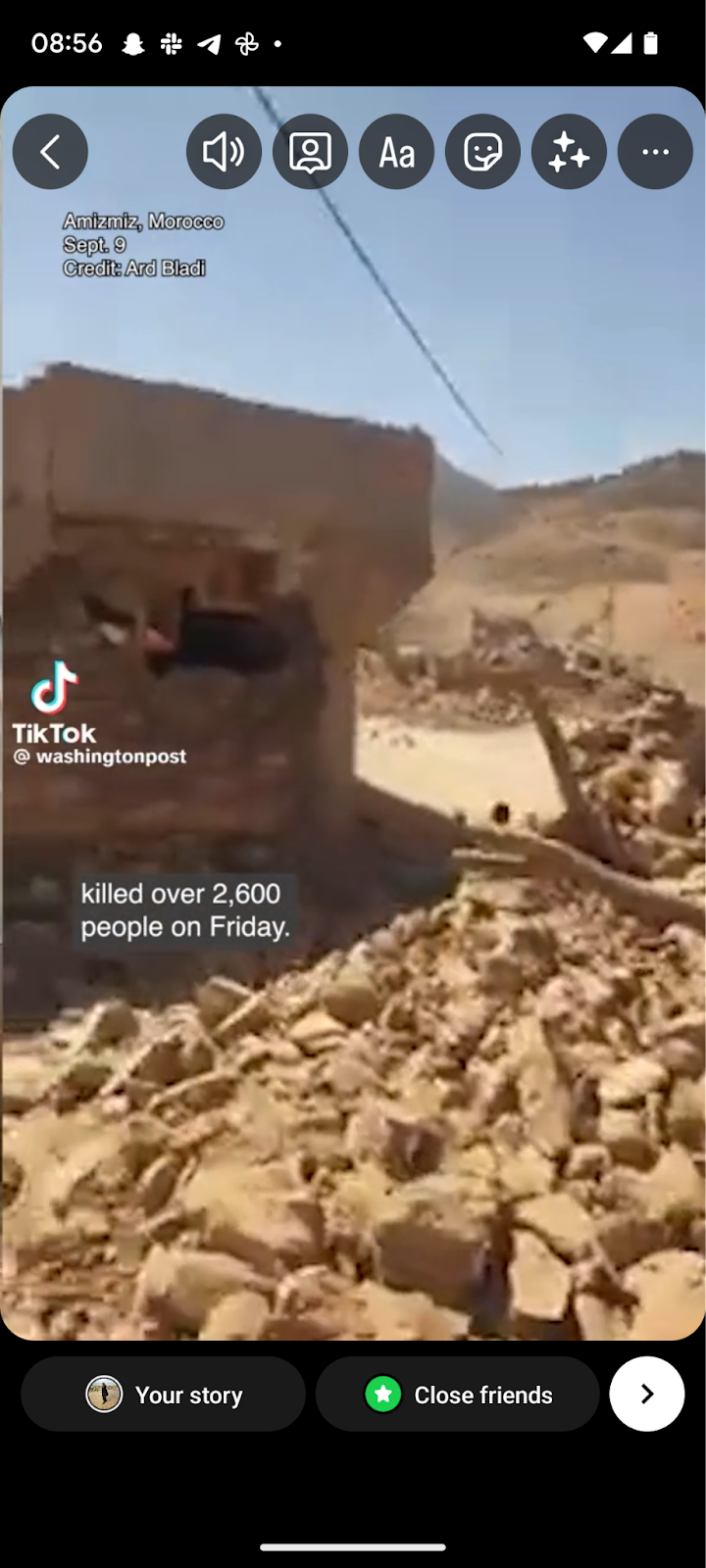
For example, in 2022 a video of an alleged news report went viral. In the video, a reporter stands in front of a line of ‘body bags’ discussing the Russian ‘military operation’ in an American accent and the caption reads “Ukranian Health Ministry: 57 dead, 169 hurt across Ukraine as Russia launches attack.” During the report, the person in the body bag behind the reporter starts to move. The video was shared with an array of claims, ranging from the dead coming back to life to assertions that the Ukrainian authorities were staging deaths to grow support for their cause. Elementary fact-checks will show any savvy individual that this footage did not show what was claimed. A quick search on Google of the reporter’s name shows that they have never reported on such an incident. A reverse image search using a screenshot from the video reveals that the news report was taken and manipulated from coverage of a climate protest in Austria in February 2022. Fake audio had been added to the video and was easily disguised by the fact the reporter’s mouth could not be seen as he/she was wearing a mask. The Associated Press originally debunked this claim and their factcheck can now be found linked to the original misleading post on Facebook.
The church also debunked the attack on Facebook.
The same area was attacked at a later date, on October 19, 2023, and two assembly halls on the church property were then damaged.
In the process of geolocating footage related to the viral video claiming to show the church site, Bellingcat found evidence that strikes did occur in densely populated areas in the vicinity of several schools. The amplification of the false church claim, as a result, may have obscured a real violation. You can read the full debunk here.
4. Remember that the Same Location Doesn’t Mean the Same Incident
Even if the footage is from the area, it doesn’t mean it is from the same event.
One simple way to check is to use Google reverse image search on video screenshots to see if they’ve been posted before.
For example, Bellingcat contributor Chris Osieck found that this video allegedly showing rocket fire in Palestine in October was indeed filmed in the Gaza Strip, but that it was from May 13, 2023.

He found an earlier instance of the footage labelled as showing the destruction of the Za’anin family’s home in the same region. This attack was part of fighting that occurred in May 2023.
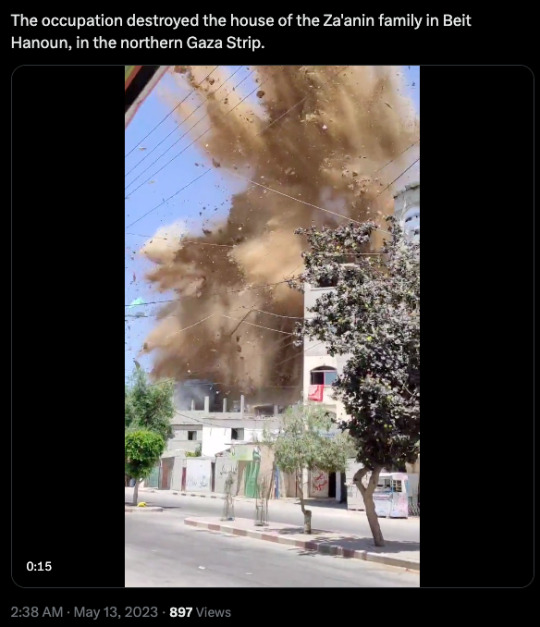
5. Be Savvy to Manipulation and AI Generation
When all footage or photographs connected to an event go viral, you often see accounts pop up distributing manipulated or altogether fake imagery. Free and easy to access AI-powered image generation tools have now made this type of content faster to create and more common. Although not always accurate, tools like aiornot.com can help disprove claims quickly.
For example, a video went viral in March 2022 allegedly showing Ukraine President Volodymyr Zelenskyy telling Ukrainian soldiers to “lay down their arms” and claiming that he had decided to “return Donbas” to Russian control. Many media outlets and Zelenskyy himself debunked the video. Whilst watching the video, one can see his head appears disproportionately sized in contrast to his body. His voice is also slower and deeper than in usual addresses.
6. Be Cautious of State Actors, Which Sometimes Share Staged or Unreliable Footage
In times of conflict, it is not unknown for state actors to imply bad faith on the part of their adversaries. In some cases, staged videos appear online. For example, in March 2023, a dashcam video circulated allegedly showing a Ukrainian soldier abusing a Russian-speaking Ukrainian citizen. Pro-Russian figures and Russia’s Foreign Ministry shared the video on social media. Bellingcat and other eagle-eyed viewers, however, geolocated the footage to deep inside Russian-controlled territory. You can read the full story here.
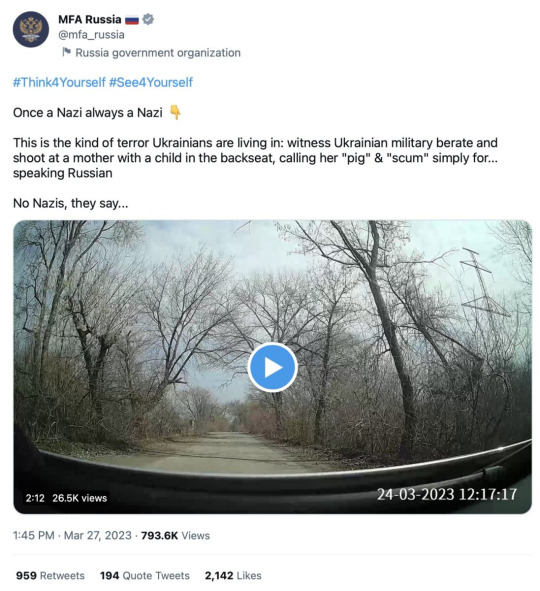
7. Know That, Sometimes, News Organisations Get it Wrong
When you discover new claims about footage, always check for a secondary media source, ideally one that has obtained the information independently of the first source. News organisations and leading figures can sometimes use quotes from each other as sources of information (see an example that we found here) and sometimes verification steps slip through the cracks. For example, in a famous example in 2019, ABC News broadcasted a fake video on both its ‘World News Tonight’ and ‘Good Morning America’ programmes. The video was reportedly sent to them by a trusted fixer and claimed to show the Turkish military bombing Kurdish civilians in a Syrian border town. Viewers spotted that it looked incredibly similar to a video on YouTube from a Kentucky gun range called Knob Creek. The footage had been altered slightly, but the two video timelines matched. ABC issued a statement and took down the video from their broadcasting.
8. Protect Your Mental Health
Watching footage from war zones can cause trauma.
Be careful viewing unknown footage. There is almost always an abundance of highly disturbing content circulating during times of conflict.
Always ask yourself if there is a genuine reason you need to view this footage. Organisations like Bellingcat have teams of researchers trained to view such footage with therapeutic support in place to assist them. If you do find something that needs attention, you can share it with a trusted news source rather than viewing it and amplifying it yourself.
If you are an open-source researcher, you can find Bellingcat’s guide explaining ways to better protect your mental health whilst undertaking this role here. The Dart Center also has robust advice on the risk of vicarious trauma.
#disinformation#misinformation#propaganda#fog of war#fact check#bellingcat#journalism#ukraine#russia#palestine#israel
14 notes
·
View notes
Text
Hello there,
Welcome to my blog.
I’m Redley. Relatively new to Tumblr still, but I’ve been finding that I’m comfy here. Though it still feels awkward (thanks, dysphoria), I prefer she/her pronouns. I don’t mind they/them, but… meh. Note that Redley is neither my legal or chosen name; it is solely a handle, and I will only tell you my chosen name if I feel comfortable with you. If I extend that trust, please treat it with respect. If you don’t, I will remember.
Here’s the main stuff I’m comfortable sharing or want you to know about me:
1) I’m transfem, but haven’t had an opportunity to do much actual transitioning yet. Dislike my voice, adore my hair. My luscious, glorious, flowing hair.
1.5) I am likely pansexual, but I haven’t done enough research to know for sure. All I know is, people are… well, people are hot.
2) I live in Florida, but was not raised here. The climate and scenery are nice; the local government sucks ass though. Also, I miss snow.
3) I’m a diagnosed autistic, falling somewhere on the high-functioning end of the spectrum. I’m on prescribed antidepressants, but have not been able to find a psychologist/psychiatrist yet because it’s fucking Florida.
4) There are a lot of things and people I don’t understand, but I’m always open to learning. Trying new food is a special passion of mine, and I’ve met some quite fascinating new people since starting this blog. (*eoughck* @potentially-a-poser *aucghk* @analogue-system *ahem*)
5) I will not tolerate hateful behavior. You will be immediately blocked for shit like denying any of the shades of aro/ace individuals as being part of the LGBTQIA+ community. If you see me spreading misinformation or saying something that excludes members of the community, please tell me. I’ll research the matter, as well as review any sources you send me.
5.5) okay so I think I’m demiromantic
6) I do not mind being tagged or sent asks or otherwise brought into conversations. People who abuse that will likely get blocked, but whatever your social anxiety is telling you probably comes nowhere near ‘abuse’ in my book. Anonymous asks are enabled, but that can likewise change if the feature is abused. Hate asks will be blocked, naturally.
7) I would prefer being asked before you directly message me. If you don’t, there is a possibility you’ll be blocked, but it’s not a guarantee. I don’t want me and my friends’ conversations getting buried by anything.
8) If you consistently and frequently post tiktok/reddit memes with little to no commentary, I may block you simply out of annoyance should you repeatedly show up on my dash. It’s not personal. If something about you makes me suspicious or uncomfortable, but not outright offended, I’ll most likely notify you of my reason before I block you.
9) Age: pick a number between 1 and 100 because it’s none of your fucking business. None of you are entitled to any of my personal information, regardless of the reason. I will share only what I want.
My Behaviors
There are certain things I gravitate towards or away from on this site. Here’s some:
1) I am most likely to follow people who are part of the LGBTQIA+ community, are mentally ill, or are dealing with some variety of personality disorder. This is mostly just due to the fact that I find the most common ground with those people. But even those who I have little common ground with, I’ll tend to find very interesting.
2) I don’t mind things like roleplay and hornyposting on my dash, but will almost certainly not interact myself, or make original posts in that category. More extreme examples won’t necessarily get you blocked or unfollowed, but… well, my filtered tags list may grow.
3) I don’t always tag reblogs. This may mean that my followers will see random things that caught my interest. It could be art, shitposting, tender affirmations, politics, or just goofy-ass Tumblr shit. If something I regularly reblog/post about bothers you and isn’t properly tagged, let me know.
4) I am discovering that maybe, I might, perhaps, be a little bit nosy. When I see someone receiving hate or suffering and stressed, I am likely to take it upon myself to do or say something to try to make them feel better. If I bother you with this, I will not be hurt or offended if you block me. In general, I will do my best to be respectful of it when people draw boundaries, so don’t hesitate to draw any you feel necessary.
5) If your intentions are pure, you will likely find that I try to be forgiving and/or understanding of your mistakes, at least in regards to interacting with me. (The /or is a very important distinction.)
6) I will often be attracted to dark, tragic, or dystopic works of art/fiction. I get a form of catharsis from such media, and some of my writing will reflect that.
That’s about it.
That’s all the important stuff I can think of, aside from tags which are at the end. Still, this post may be updated or rewritten in the future. In general, just be kind and open-minded, and we’ll get along fine. Even if you disagree with me, as long as you are civil and rational about things, I’ll likely have no problem interacting with you.
Be safe, and be yourself! <3
🇵🇸🏳️⚧️🏳️🌈
My Tags:
#redley’s playlist - Some of my favorite songs!
#redley’s photos - Photos taken by/of me!
#writing - Writing related things and occasionally stuff I’ve made! (#poetry will also contain some of my work)
#let me just frame this one - My personal favorite posts by others. Put that right up on the wall!
#cw/tw: [content] - I will tag posts that I recognize may be disturbing to others with content warnings and/or trigger warnings. This way, you can filter content that may be harmful to your mental health to view. If a post is missing an important one, let me know.
#intro post#transgender#autism#writers on tumblr#lgbtqia+#demiromantic#queer#free palestine#🚗🔨⚒️💥#not really a part of any fandoms but i love browsing them. it’s very fun#fuck tumblr staff#fuck the us government#maybe if the site survives photomatt swinging his cock around i’ll upload timeline photos one day
8 notes
·
View notes
Text
Mini(?) World Lore

The world of GoldenDusk actually has some....WORLD-BUILDING!!!
Yes, that is right a map and countries and history and information about each country.
So, this is just a lore dump I suppose. I mean the information I'll being dropping will also be able to be found in-game but...Who knows?
It could change at any time and how I format things. But anyway here's the World Lore & Map I have currently!
~Under the Cut~
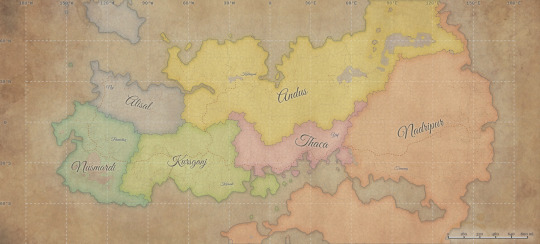
World Map of GoldenDusk : Ladesh

Andus
Called 'The Country of Agriculture', Andus is a country of much land and people. It thrives on it's farms and many lakes for fish. It has fertile soil and warmer temperatures. Though there are two places in Andus where it is abnormal, a heat desert and a frozen desert. People who come from Andus have darker shades of skin from working in the sunny sky and have almost muted neutral shades of color for hair and eyes. It is a center for farming, fishing and many materials. It is currently in a 20/22 year-war with Nadripur.

Nadripur
Known as 'The Country of Holiness', Nadripur has a lot of inhabitants and land. It thrives on it's healing abilities and mystical properties found on the land and belief system. It has beautiful scenery, cooler temperatures and precious stones. Though most of the land is reserved for holy building and reservations. People who come from Nadripur have medium shades of skin, colored hair and light shades of brown eyes. It is a center for magic, divinity and many materials. It is currently in a 20/22 year war with Andus.

Thaca
Known as 'The Country of Wealth/Neutrality', Thaca is a small country but has many, many citizens for it's size. It thrives on it's trade and diplomacy. It has touristy beaches, and lots of cities. Though most of the land is dedicated for trade and tourists. People who come from Thaca have lighter shades of skin, dark colored hair and light cool colored eyes. It is a center for trade, diplomacy and money. It is a exclusively neutral country. Especially, since it lies in between Andus and Nadripur.

Kursganj
Known as 'The Country of Knowledge', Kursganj is a medium sized country and has a sizable population. It thrives on it's technology, research and magic. It has meticulously planned cities and large research center. Though most of the land is dedicated for research and government. People who come from Kursganj have medium-darker shades of skin, lighter shades of hair and medium warm colored eyes. It is a center for knowledge, research and education. It is sided with Nadripur even though they have never been on very friendly terms before the war.

Nusmardi
Known as 'The Country of Isolation/Secrets', Nusmardi is a smaller country and has a smaller population. It thrives on it's diverse climate and mystical 'charm'. It has ancient towns, cities and clear crystal water and jewels.Though most of the land is dedicated for the people and sanctuaries. People who come from Nusmardi have very diverse colors but tend to have light skin, and light colored eyes and hair. It is a center for tradition, magic, and art. It is a neutral country and being isolated it has many secrets which make it highly suspicious and a possible unknown ally for either side, and thus a possible unknown enemy.

Alisal
Known as 'The Country of Mystery/War', Alisal is a smaller country with an big island and has a unknown population. It thrives on it's weapons, ores and handmade products. It has scattered(almost hidden) villages, towns and numerous ancient ruins. Though most of the land is dedicated for war, hunting and is free land. People who come from Alisal have darker shades of skin, dark colored shades of hair and dark colored eyes. It is a center for materials, ancient history, war and tradition. It is sided with Andus though they themselves don't know much about their ally.

*P.S.- The 20/22 year thing is dependent based on which part of the game you are in as your age changes, I'll update it once I figure out what age(s) you are during most of the story. Right now it's based on Prologue ages.*
#interactive story#itch.io#twine#twine interactive fiction#twine sugarcube#goldendusk#lore#world lore#world map#lore dump
7 notes
·
View notes
Text
The promised intel has arrived!

To be perfectly honest, I thought you were playing me. I went along with it for the sake of having a mystery to solve, which I now deeply regret. But if you do have information to share, I'm all ears.
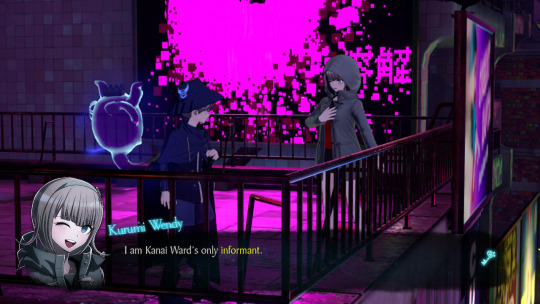
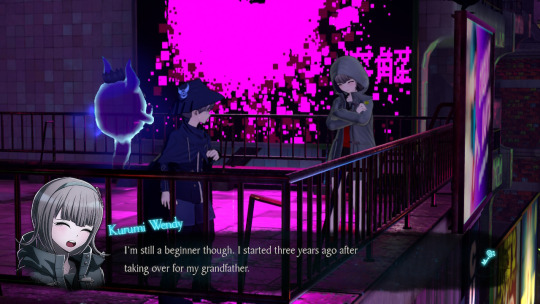
You have a family heritage of telling things to cops? Are you sure your grandfather didn't say "information broker"? Is it possible you misheard?
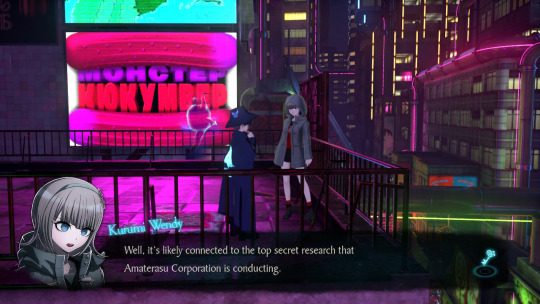
Right. You mentioned the top secret research before. Is it related to the forever-rain that started up three years ago? Because that seems pretty suspicious.
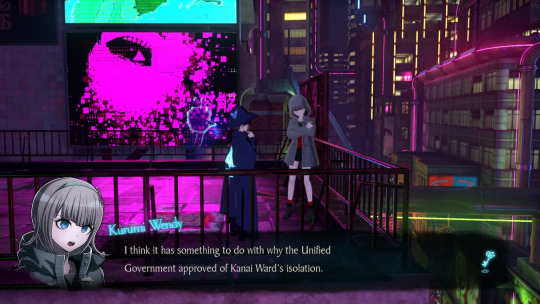
Or it could be related to that. That's a mystery too!
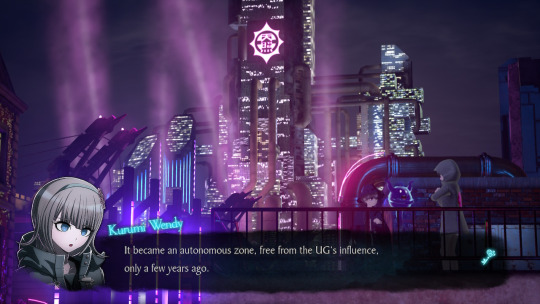
Right around the time the forever-rain began.
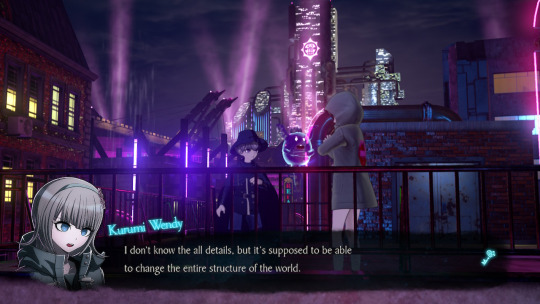
Oh, so that would be why it relates to the Global Mystery that Number One was talking about. Whatever that is!
Secret research to change the world's structure, possibly related to forever-rain. What, are they doing climate control experiments?
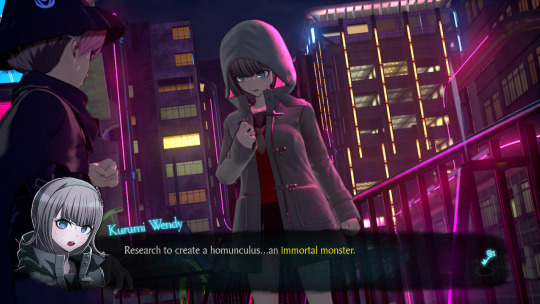
Oh shit, they're trying to create Father from Fullmetal Alchemist! Genuinely wasn't expecting that swerve. I mean, I can't exactly call this series grounded when I'm attached at the hip to an eldritch horror who devours the souls of mysteries, but I kinda thought Shinigami was, like, the one supernatural thing.
My bad. That's on me.
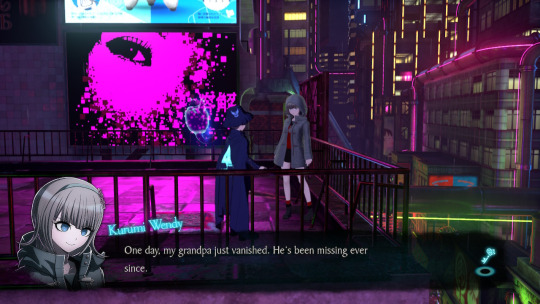
Amaterasu probably sacrificed him to create a Philosopher's Stone. He's being used to turn coal into toaster ovens now. I'm sorry for your loss.
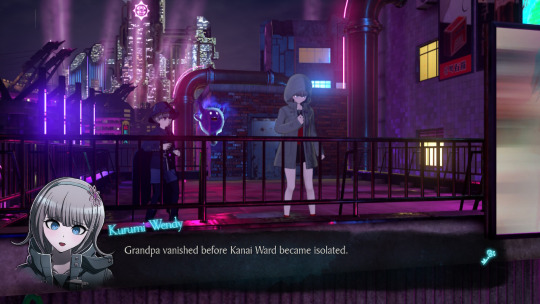
Watch, he turns out to be Number One.
8 notes
·
View notes
Text
Facing an increasingly suspicious research climate, a growing number of Chinese scientists are leaving the United States for positions abroad, the latest indicator of how worsening U.S.-China relations are complicating academic collaboration and could hamstring Washington’s tech ambitions.
Chinese scientists living in the United States have for decades contributed to research efforts driving developments in advanced technology and science. But a growing number of them may now be looking elsewhere for work, as deteriorating geopolitical relations fuel extra scrutiny of Chinese researchers and Beijing ramps up efforts to recruit and retain talent. Between 2010 and 2021, the number of Chinese scientists leaving the United States has steadily increased, according to new research published last month. If the trend continues, experts warn that the brain drain could deal a major blow to U.S. research efforts in the long run.
“It’s absolutely devastating,” said David Bier, the associate director of immigration studies at the Cato Institute. “So many of the researchers that the United States depends on in [the] advanced technology field are from China, or are foreign students, and this phenomenon is certainly going to negatively impact U.S. firms and U.S. research going forward.”
From semiconductor chips to artificial intelligence, technology has been at the forefront of U.S.-China competition, with both Washington and Beijing maneuvering to strangle each other’s sectors. Cooperation, even in key sectors like combating climate change, has been rare.
From 2010 to 2021, the number of scientists of Chinese descent who left the United States for another country has surged from 900 to 2,621, with scientists leaving at an expedited rate between 2018 and 2021, according to research published in the Proceedings of the National Academy of Sciences (PNAS). Nearly half of this group moved to China and Hong Kong in 2010, the study said, and a growing percentage of Chinese scientists have relocated to China over the years.
While this number represents a small fraction of the Chinese scientists in the United States, the uptick reflects researchers’ growing concerns and broader apprehension amid a tense geopolitical climate. After surveying 1,304 Chinese American researchers, the report found that 89 percent of respondents wanted to contribute to U.S. science and technology leadership. Yet 72 percent also reported feeling unsafe as researchers in the United States, while 61 percent had previously considered seeking opportunities outside of the country.
“Scientists of Chinese descent in the United States now face higher incentives to leave the United States and lower incentives to apply for federal grants,” the report said. There are “general feelings of fear and anxiety that lead them to consider leaving the United States and/or stop applying for federal grants.”
The incentives to leave are twofold. Beijing has funneled resources into research and development programs and has long attempted to recruit scientists, even its own, from around the world. For one of its initiatives, the Thousand Talents Plan, Beijing harnessed at least 600 recruitment stations worldwide to acquire new talent. “China has been really trying to lure back scientists for a long time,” said Eric Fish, the author of China’s Millennials.
But this latest outflow of Chinese scientists accelerated in 2018, the same year that then-U.S. President Donald Trump unveiled the China Initiative, a controversial program that was aimed at countering IP theft—and cast a chill over researchers of Chinese descent and collaborations with Chinese institutions. In 2020, he also issued a proclamation denying visas for graduate students and researchers affiliated with Chinese universities associated with the military.
Although the Biden administration shut down the China Initiative, experts warn that its shadow still looms over Chinese scientists. More than one-third of respondents in the PNAS survey reported feeling unwelcome in the United States, while nearly two-thirds expressed concerns about research collaboration with China.
“There is this chilling effect that we’re still witnessing now, where there is a stigma attached to collaboration with China,” said Jenny Lee, a professor at the Center for the Study of Higher Education at the University of Arizona.
The challenges are emblematic of how the breakdown in U.S.-China relations has thrown universities into a geopolitical firestorm, particularly as some states’ lawmakers pressure them to sever ties with Chinese counterparts. On the U.S. side, interest in Mandarin language studies and study abroad has plummeted over the years, largely the result of worsening ties, Beijing’s growing repression, and the coronavirus pandemic. Today, while there are roughly 300,000 Chinese students in America, only 350 Americans studied in China in the most recent academic year. If interest continues to recede, experts warn of spillover effects that could hamper Washington’s understanding of Beijing.
“We’re losing a generation of people who are knowledgeable about China,” said Daniel Murphy, the former director of the Fairbank Center for Chinese Studies at Harvard University. “I’m concerned that the United States is going about this issue in a way that excessively focuses on risks of the academic relationship, without due consideration for the benefits. And I think we see this in a whole host of arenas, and that it’s bipartisan.”
At the same time as a growing number of Chinese scientists exit the United States, new students appear to be facing higher barriers to entry as student visa denials and backlogs reach record high levels. According to a blog post by the Cato Institute, student visa denials peaked at about 35 percent in 2022—the highest rate recorded in two decades.
Student visa denial data is not available by nationality, but Bier, the Cato Institute expert who wrote the piece, said that there is a high degree of correlation between denial rates for B-visas, or tourist visas, and student visas. “Having reviewed the B-visa denials in China, it’s pretty clear that the Chinese overall visa denial rate has increased significantly over the last few years and is at a level now where it’s the highest it’s been in decades,” he said.
Just as some Chinese scientists are looking abroad, these challenges are pushing a growing number of international students to turn elsewhere for academic opportunities. Students are increasingly heading to countries like Canada, Australia, Japan, and the United Kingdom, all of which are opening their doors to high-skilled workers and researchers. To attract more talent, the United Kingdom has issued “Global Talent” and “High Potential Individual” visas, which allow scholars from top universities to work there for 2-3 years and 1-5 years, respectively.
Universities are being impacted “by geopolitical tensions, by political agendas, and so it’s certainly inhibiting U.S. universities’ ability to attract the best and brightest,” Lee said.
30 notes
·
View notes